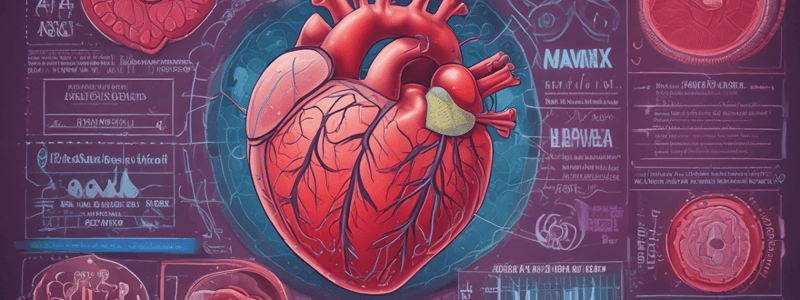Podcast
Questions and Answers
What is the primary purpose of measuring the timing of biomarker release in diagnosing myocardial infarction?
What is the primary purpose of measuring the timing of biomarker release in diagnosing myocardial infarction?
- To detect re-infarction and determine the effectiveness of treatment (correct)
- To differentiate between acute and chronic infarction
- To identify the location of the occluded artery
- To determine the severity of the infarction
What is the primary goal of revascularisation in the management of myocardial infarction?
What is the primary goal of revascularisation in the management of myocardial infarction?
- To restore blood flow to the affected area within 90 minutes of first medical contact (correct)
- To prevent re-infarction and reduce the risk of complications
- To reduce the severity of ischemic symptoms
- To improve cardiac function and reduce morbidity
Which of the following biomarkers normalizes quickest after a myocardial infarction?
Which of the following biomarkers normalizes quickest after a myocardial infarction?
- CK-MB (correct)
- Troponin I
- Myoglobins
- Troponin T
What is the primary advantage of percutaneous coronary intervention (PCI) over fibrinolytic therapy in the management of myocardial infarction?
What is the primary advantage of percutaneous coronary intervention (PCI) over fibrinolytic therapy in the management of myocardial infarction?
What is the primary purpose of an electrocardiogram (ECG) in the diagnosis of myocardial infarction?
What is the primary purpose of an electrocardiogram (ECG) in the diagnosis of myocardial infarction?
Flashcards are hidden until you start studying
Study Notes
Diagnosis
- ECG is used in diagnosis
- Biomarkers such as Myoglobins, Troponin I, T, CK-MB are used in diagnosis, which leak out of cells during an MI
- Echocardiogram is used to detect wall motion abnormalities
- Cardiac catheterisation is used in diagnosis
Biomarkers
- Important to understand the timing of biomarker release
- CK-MB normalises quicker and can be used to determine re-infarction
- Biomarkers are released in a specific order after an MI, understanding this order is crucial
ECG
- Predicted distribution of ST-elevation relative to occluded artery is important in diagnosis
Diagnostic Approach
- No specific diagnostic approach is mentioned, but a combination of the above methods is likely used
Management Principles
- All patients should receive anti-ischemic and analgesic medications early in care
- Revascularisation should occur within 90 minutes of first medical contact
- Percutaneous coronary intervention (PCI)/coronary angioplasty is the preferred revascularisation method
- Fibronlytic therapy should be used if PCI cannot be performed
Studying That Suits You
Use AI to generate personalized quizzes and flashcards to suit your learning preferences.




